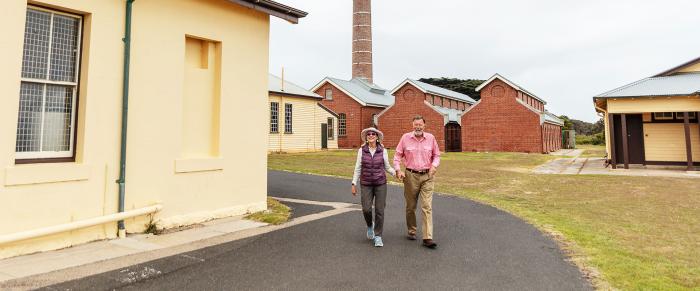Quarantine Station - Point Nepean National Park |

Point Nepean Quarantine Station offers a glimpse into the early European history of Victoria. Established in 1852, explore nearly 50 heritage-listed buildings. Learn about life at this once-remote location and the station's critical role in protecting Australia from introduced diseases.
A visit to the Quarantine Station offers a unique opportunity to see how a large number of new Australians spent their first few weeks in their new country.
This community of hospitals, disinfecting complex, morgue, cemetery and other defunct buildings comprised an infectious disease facility which processed newly arrived humans and livestock alike.
The Quarantine Station began here in 1852 on what was a desolate, windy and unwelcoming stretch of land. The extent of the facilities then was a few houses left by a community of lime burners who had vacated the area.
There have been several building phases since. The first buildings were simple wooden structures. In the late 1850s a jetty and five two-storey hospital blocks were erected.
In the 1860s a communal bathhouse was built along with a washhouse outfitted with dedicated facilities to deal with infected clothing.
A second building phase occurred in the late 19th century. The Quarantine Station was now receiving animals as well as people. A jetty for this purpose was built at Observatory Point. Other infrastructure included a school for residents and a crematorium. The latter serviced the leprosy patients who were housed well away from the main Quarantine Station.
In 1901 the Federation of Australia was proclaimed and quarantine moved from state to Commonwealth control. This resulted in a number of new processing policies. The Foul Luggage Receiving Store, Disinfection and Boiler buildings were designed and became models for quarantine centres throughout the nation.
The large centrally located Administration Building was erected in 1916. With its handsome façade the building was an impressive addition to the Station. Except for an intense period during the Spanish Flu pandemic in 1919 during which 12 wooden 'Influenza huts' were built, the need for isolated quarantine facilities began to lessen.
The army was billeted here during World War II, and the Station became the Officer Cadet School between 1952 and 1985. A final building phase occurred in the 1960s resulting in Army barracks, a library and gymnasium.
The Quarantine Station ceased its original role in 1980, but it continued to be used by the Army with the the School of Army Health using the facilities between 1985 and 1998.
In the 1990s, the Quarantine Station also played host to 400 Kosovars, refugees from the Bosnian War of 1992-95. During this time the Kosovars were treated to Australian hospitality. They were given bilingual support, school and a weekly allowance. Families were entertained with visits to museums, zoos, festivals and special events. By June 1999 it was declared safe for return home.
In 2009 the Quarantine Station became part of the Point Nepean National Park.
❊ What's On ❊
➼ Quarantine Station - Historical Ghost Tour - Point Nepean
❊ Address ❊
⊜ Point Nepean National Park Point Nepean View Map
❊ Web Links ❊
➼ Quarantine Station - Point Nepean National Park
➼ www.quarantineartfair.com
❊ Also See... ❊
➼ Point Nepean National Park
Disclaimer: Check with the venue (web links) before making plans, travelling or buying tickets.
Accessibility: Contact the venue for accessibility information.
Update Page







